Recording audio on vinyl records is an art form that has stood the test of time, appreciated by audiophiles for its warm analog sound and tactile experience. When embarking on the process of recording onto vinyl, one of the critical decisions to make is choosing the appropriate rotational speed for your record—33 RPM or 45 RPM. In this article, we’ll explore the factors to consider when deciding between these two options to help you make an informed choice.
Understanding Rotational Speeds
Before delving into the factors to consider, let’s briefly review the basics of 33 RPM and 45 RPM:
- 33 RPM (Revolutions Per Minute): This is the standard speed for long-playing (LP) records. 33 RPM records are designed for longer durations and can typically accommodate full-length albums.
- 45 RPM (Revolutions Per Minute): These records are typically used for singles or shorter tracks. They spin faster than 33 RPM records and generally have wider grooves to capture more detail.
Factors to Consider
When choosing between 33 RPM and 45 RPM for your vinyl recording, you should consider the following factors:
- Recording Duration: One of the most critical factors to consider is the duration of the content you want to record. If you are recording a full album or a longer set of tracks, 33 RPM is typically the better choice. On the other hand, if you are recording a single or a short EP, 45 RPM may be more suitable.
- Sound Quality: The choice of rotational speed can influence sound quality. 45 RPM records have wider grooves, which allow for more detail to be captured during the recording process. This can result in greater clarity and precision, making 45 RPM a preferred choice for audiophiles aiming for the best sound quality.
- Bass Response: Wider grooves on 45 RPM records can enhance bass response. If your content features deep bass elements, 45 RPM may be a better choice due to its ability to accurately reproduce low-frequency sounds.
- Surface Noise: The wider grooves on 45 RPM records also tend to reduce surface noise, such as pops and crackles, because the stylus has more space to navigate. This can result in a cleaner listening experience.
- Recording Equipment: The quality of your recording equipment, including the turntable and the stylus, can also play a role in your choice of rotational speed. Higher-quality equipment may be better equipped to extract the full potential of 45 RPM records.
- Musical Genre: The genre of music you are recording can influence your choice. Some genres, like classical and jazz, where detail and sound quality are paramount, may benefit from 45 RPM, while others, like rock or pop, can work well with 33 RPM.
- Personal Preference: Ultimately, the choice between 33 RPM and 45 RPM may come down to personal preference and your specific goals as a recording artist or enthusiast. Consider the type of listening experience you want to create.
Conclusion
Choosing the appropriate rotational speed for your vinyl recording is a crucial decision that should be based on your specific needs and preferences. Both 33 RPM and 45 RPM have their unique advantages, and the choice depends on factors such as recording duration, sound quality, bass response, equipment quality, musical genre, and personal preference. Take time to carefully consider these factors and conduct listening tests if possible to determine which speed best suits your recording project. Ultimately, the choice should align with your artistic vision and the listening experience you wish to offer your audience.


